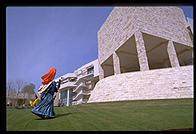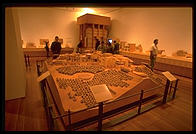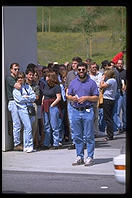
Getty Museum
by Philip Greenspun; created 1998
Home : Travel : California : Getty Museum
 The "new
Getty" cost $1 billion to construct. With $1 billion, one could print a book of
full-color reproductions of all the major works in the Getty collection and mail
a copy to every home in the United States. What then is the point of having a
physical museum? It can't be to show people the art because that would be better
accomplished by sending everyone a book.
The "new
Getty" cost $1 billion to construct. With $1 billion, one could print a book of
full-color reproductions of all the major works in the Getty collection and mail
a copy to every home in the United States. What then is the point of having a
physical museum? It can't be to show people the art because that would be better
accomplished by sending everyone a book.
Most art museums are like K-Mart: one building large enough to hold all the stuff. The Getty Center is like the Stanford Shopping Mall: separate buildings with covered walkways in between.
The "new Getty" has espresso bars, cafes, outdoor patios, stilt puppets, and a constantly replenished supply of musicians. In some ways it owes more to Disneyland and modern shopping malls than to traditional notions of what makes an art museum.
Personally, I'm sold on the idea. Information distribution technology gets better every year. The Getty Villa was constructed in the late 1960s. In the thirty years since its construction, society has gone from high-quality books to CD-ROMs to the Internet. If one were going to build an art museum for the next thirty years, it had better do something more than show people the art.
The Getty does a lot more. Not everyone can get there. You have to live in or be visiting Los Angeles. You have to make a parking reservation or take the bus and stand in line. But once you're there, everything in the carefully crafted environment focusses your attention on the importance of art and aesthetics.
There is something about the underground parking lot that reminds me a lot of my own garage back home. But I can't quite figure it out...
Make sure to stop and use the bathrooms at the top of the garage elevator, as the rest rooms in the museum are famous for lines. After getting out of the rest room, take the tram up the hill to the museum.
People actually stand on line to spend money. These folks are ripe to enter the world of electronic commerce.
The Getty is perched high on a hill overlooking Los Angeles.
The art nerd press, and even The New Yorker spent a lot of ink on the hissy fit between the architect (Richard Meier) and the garden designer (Robert Irwin). If you hadn't heard about the controversy, you'd probably never notice that there was anything incongruous about the garden.
Here are some flower photos that I took in the garden. They demonstrate that carrying a $1400 macro lens isn't much good if you're too lazy to also carry a tripod.
With so many outdoor patios, the Getty Center is probably the last place in California where it will be legal to smoke a cigarette.
Oh yes, the art. There are little pavilions each with a few galleries. You never have to see much without taking a little break on an outdoor patio or the courtyard.
The museum is open late many evenings.
There are actually a whole bunch of buildings that are part of the Getty Center but aren't part of the public museum. The Getty Foundation does a lot of education, research, and conservation. Here are some random snapshots from miscellaneous parts of the complex.
 It is
easy to drive to the new Getty, which is right on Interstate 405. But, as with
the old Getty, it isn't so easy to park unless you've called (310) 440-7300 and
made a reservation. Check
the
Getty's Web site for up-to-the-minute information and bus/taxi
directions.
It is
easy to drive to the new Getty, which is right on Interstate 405. But, as with
the old Getty, it isn't so easy to park unless you've called (310) 440-7300 and
made a reservation. Check
the
Getty's Web site for up-to-the-minute information and bus/taxi
directions.
I was at the Getty at 11 am on a Saturday morning in March 1998 and folks
who'd arrived by bus had to stand on line for about an hour before earning the
right to stand on line for another 20 minutes before boarding the tram.
Below are some snapshots from "the old Getty" in Malibu, which is being renovated and will eventually reopen to house the Getty collection of antiquities.
PhotoCD scans by Advanced Digital Imaging. Text and photos copyright 1998 Philip Greenspun.